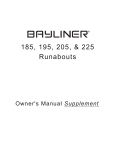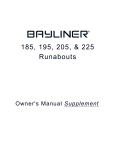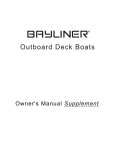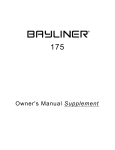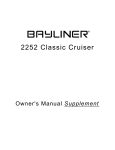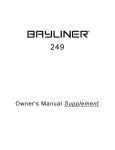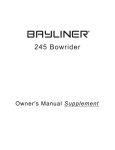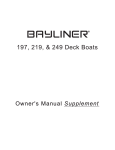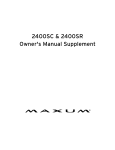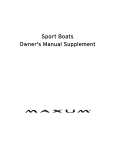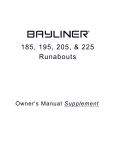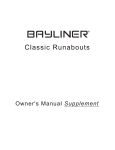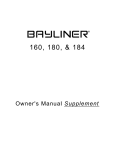Download Bayliner 225 Specifications
Transcript
Engine Serial Number: _____________________________________________ Hull Identification Number:__________________________________________ Hull Identification Number • The Hull Identification Number (HIN) is located on the starboard side of the transom. • Record the HIN (and the engine serial numbers) in the space provided above. • Please refer to the HIN for any correspondence or orders. HIN LOCATION © 2003 Bayliner Technical Publications. All rights reserved. No part of this publication may be reproduced, stored in any retrieval system, or transmitted in any form by any means, electronic, mechanical, photocopying, recording or otherwise, without prior written permission of Bayliner. Printed in the United States of America. General Notes The material in this document is for information only and is subject to change without notice. While reasonable efforts have been made in the preparation of this document to assure its accuracy, Bayliner assumes no liability resulting from errors or omissions in this document, or from the use of information contained herein. Due to our commitment to product improvement, Bayliner reserves the right to make changes in the product design, specifications, and equipment at any time without notice or obligation. Illustrations and/or photos may show optional equipment. All Bayliner products meet or exceed USCG (Unites States Coast Guard) and/or NMMA (National Marine Manufacturer’s Association) construction standards. Manufactured with 1,1,1 Trichloroethane, a substance which harms public health and environment during the manufacturing process by destroying ozone in the upper atmosphere. Proprietary Rights This document discloses subject matter in which Bayliner has proprietary rights. The information and design disclosed herein were originated by and are the property of Bayliner. Neither receipt nor possession thereof confers or transfers any right to reproduce, copy, alter or disclose the document or any part thereof, any information contained therein, or to construct boats or any item from it, except by written permission from or written agreement with Bayliner. This document is to be returned upon request to Bayliner. CONTENTS 1 Chapter 1: Welcome Aboard! 16 Chapter 4: Propulsion & Related Systems 1 Dealer Service 1 Warranty Information 16 Engine 1 Boating Experience 16 Engine Room Ventilation System 2 Safety Standards 17 2 Engine & Accessories Guidelines 3 Engine & Accessories Literature 3 Qualified Maintenance 18 Chapter 5: Controls & Gauges 3 Special Care For Moored Boats 18 Steering 4 Carbon Monoxide (CO) 18 Shift/Throttle Lever 18 Power Trim and Tilt 18 Gauges 4 5 5 6 6 6 6 Facts about CO Where and How CO Can Accumulate How to Protect Yourself and Others From CO Trip Checklist Monthly Checklist Annual Checklist More Information 18 18 18 18 7 Chapter 2: Product Specifications 19 7 185 19 8 205 9 225 10 Chapter 3: Locations 10 Exterior Views 10 11 12 13 14 15 Hull Views Extended Swim Platform (If Equipped) 185 Deck View 205 Deck View 225 Deck View Component Locations Fuel System 17 Fuel Fill and Vent 17 Fuel Filters Cleaning Gauges Gauge Fogging Radio Transmission Interference Fuel Gauge Chapter 6: Plumbing Bilge Pump 21 Auto-float Switch (225 Only) 22 Freshwater Transom Shower (If Equipped 225 Only) 24 Chapter 7: Deck Equipment 24 Cleats and Tow Eyes 24 Ski Tow Ring 25 Ski-Tow Tower (If Equipped) 25 Attaching the Ski-Tow Rope 26 Folding Ski-Tow Tower (205 & 225 Only) 27 Canvas (If Equipped) 27 28 29 30 31 Convertible Top Side Curtains (If Equipped) 185 Bimini Top (If Equipped) 205/225 Bimini Top (If Equipped) Bow Cover (If Equipped) 32 Chapter 8: Entertainment Systems 38 Chapter 11: Electrical System 32 Audio System 39 12-Volt DC System 33 33 39 39 39 39 Chapter 9: Convertible Seats, Beds, & Tables Sleeper Seats (If Equipped - 185/205 Only) 40 33 Operating Positions 33 Lounge positions 34 Jump Seat To Sunlounge Conversion (If Equipped - 185/205 Only) 35 Passenger Seat to Lounge Conversion (225 Only) 37 Chapter 10: Lights 37 Care and Maintenance 37 Navigation Lights Battery Fuses and Circuit Breakers Alternator 12-Volt Accessory Outlet(s) Electrical Routings 40 185 & 205 Deck Electrical Harness 41 225 Deck Electrical Harness 42 Hull Electrical Harness 43 Wiring Diagrams 43 185 & 205 44 225 45 Important Records 46 Float Plan Hazard Boxes & Symbols The hazard boxes and symbols shown below are used throughout this supplement to call attention to potentially dangerous situations which could lead to either personal injury or product damage. Read ALL warnings carefully and follow all safety instructions. ! DANGER! This box alerts you to immediate hazards which WILL cause severe personal injury or death if the warning is ignored. ! WARNING! This box alerts you to hazards or unsafe practices which COULD result in severe personal injury or death if the warning is ignored. ! CAUTION! This box alerts you to hazards or unsafe practices which COULD result in minor personal injury or cause product or property damage if the warning is ignored. NOTICE This box calls attention to installation, operation or maintenance information, which is important to proper operation but is not hazard related. FIRE HAZARD! EXPLOSION HAZARD! FALLING HAZARD! NO OPEN FLAME! ROTATING PROPELLER HAZARD! ELECTRICAL HAZARD! HOT HAZARD! RUN BILGE BLOWERS FOR 4 MINUTES! CO POISONING HAZARD! 185, 205 & 225 • Owner’s Manual Supplement Chapter 1: Welcome Aboard! This Owner’s Manual Supplement provides specific information about your boat that is not covered in the Sport Boat Owner’s Manual. Please study the Sport Boat Owner’s Manual and this supplement carefully. Keep the Sport Boat Owner’s Manual and this supplement on your boat in a secure, yet readily available place. Dealer Service • • • • • Your dealer is your key to service. Ask your dealer to explain all systems before taking delivery of your boat. Contact your dealer if you have any problems with your new boat. If your dealer cannot help, call our customer service hotline: 360-435-8957 or send us a FAX: 360-403-4235. Buy replacement parts from any authorized Bayliner dealer. Warranty Information • Bayliner offers a Limited Warranty on each new Bayliner purchased through an authorized Bayliner dealer. • A copy of the Limited Warranty was included in your owner’s packet. • If you did not receive a copy of the Limited Warranty, please contact your dealer or call 360-435-8957 for a copy. Boating Experience ! WARNING! CONTROL HAZARD! A qualified operator must be in control of the boat at all times. DO NOT operate your boat while under the influence of alcohol or drugs. If this is your first boat or if you are changing to a type of boat you are not familiar with, for your own comfort and safety, obtain handling and operating experience before assuming command of the boat. Take one of the boating safety classes offered by the U.S. Power Squadrons or the U.S. Coast Guard Auxiliary. For more course information, including dates and locations of upcoming classes, contact the organizations directly: • U.S. Power Squadrons: 1-888-FOR-USPS (1-888-367-8777) or on the Internet at: http://www.usps.org • U.S. Coast Guard Auxiliary: 1-800-368-5647 or on the Internet at: http://www.cgaux.org Outside the United States, your selling dealer, national sailing federation or local boat club can advise you of local sea schools or competent instructors. 1 Chapter 1: Welcome Aboard! 185, 205 & 225 • Owner’s Manual Supplement Safety Standards ! DANGER! FALLING and ROTATING PROPELLER HAZARD! NEVER allow anyone to ride on parts of the boat not designed for such use. • Sitting on seat backs, lounging on the forward deck, bow riding, gunwale riding or occupying the transom platform while underway is especially hazardous and will cause personal injury or death. ! DANGER! ROTATING PROPELLER and CARBON MONOXIDE POISONING HAZARD! • NEVER allow anyone to occupy, or hang from, the back deck or swim platform while the engine(s) are running. • Teak surfing, dragging, or water skiing within 20 feet of a moving watercraft can be fatal. ! DANGER! PERSONAL SAFETY HAZARD! ALWAYS secure the anchor and other loose objects before getting underway. The anchor and other items that are not properly secured can come loose when the boat is moving and cause personal injury or death. • Your boat’s mechanical and electrical systems were designed to meet safety standards in effect at the time it was built. • Some of these standards were mandated by law, all of them were designed to insure your safety, and the safety of other people, vessels and property. In addition to this Owner’s Manual Supplement, please read the Sport Boat Owner’s Manual and all accessory instructions for important safety standards and hazard information. Engine & Accessories Guidelines NOTICE When storing your boat please refer to your engine’s operation and maintenance manuals. • Your boat’s engine and accessories were selected to provide optimum performance and service. • Installing a different engine or other accessories may cause unwanted handling characteristics. • Should you choose to install a different engine or to add accessories that will affect the boat’s running trim, have an experienced marine technician perform a safety inspection and handling test before operating your boat again. Certain modifications to your boat can result in cancellation of your warranty protection. Always check with your dealer before making any modifications to your boat. 2 185, 205 & 225 • Owner’s Manual Supplement Chapter 1: Welcome Aboard! Engine & Accessories Literature • The engine and accessories installed on your boat come with their own operation and maintenance manuals. • Read and understand these manuals before using the engine and accessories. • Unless noted otherwise, all engine and accessory literature referred to in this supplement is included in your owner’s packet. Qualified Maintenance ! WARNING! To maintain the integrity and safety of your boat, allow only qualified personnel to perform maintenance on, or in any way modify: The steering system, propulsion system, engine control system, fuel system, environmental control system, electrical system or navigational system. • Failure to maintain your boat’s systems (listed in the warning above) as designed could violate the laws in your jurisdiction and could expose you and other people to the danger of bodily injury or accidental death. • Follow the instructions provided in the Sport Boat Owner’s Manual, this Owner’s Manual Supplement, the engine owner’s manual and all accessory instruction sheets and manuals. Special Care For Moored Boats NOTICE • To help seal the hull bottom and reduce the possibility of gelcoat blistering on moored boats, apply an epoxy barrier coating. The barrier coating should be covered with several coats of anti-fouling paint. • Many states regulate the chemical content of bottom paints in order to meet environmental standards. Check with your local dealer about recommended bottom paints, and about the laws in effect in your area. • Whether moored in saltwater or freshwater, your boat will collect marine growth on its hull bottom. • This will detract from the boat’s beauty, greatly affect its performance and may damage the gelcoat. • Periodically haul the boat out of the water and scrub the hull bottom with a bristle brush and a solution of soap and water. 3 Chapter 1: Welcome Aboard! 185, 205 & 225 • Owner’s Manual Supplement Carbon Monoxide (CO) ! DANGER! • Carbon monoxide gas (CO) is colorless, odorless, tasteless, and extremely dangerous. • All engines, generators, and fuel burning appliances produce CO as exhaust. • Prolonged exposure to low concentrations or very quick exposure to high concentrations will cause BRAIN DAMAGE or DEATH. • Teak surfing, dragging, or water skiing within 20 feet of a moving watercraft can be fatal. Facts about CO • CO poisoning causes a significant number of boating deaths each year. • Called the "silent killer", CO is an extremely toxic, colorless, odorless and tasteless gas. • CO can harm or even kill you inside or outside your boat. • CO can affect you whether you’re underway, moored, or anchored. • CO symptoms are similar to seasickness or alcohol intoxication. • CO can make you sick in seconds. In high enough concentrations, even a few breaths can be fatal. • Breathing CO blocks the ability of your blood to carry oxygen. • The effects are cumulative, even low levels of exposure can result in injury or death. Factors That Increase the Effects of CO Poisoning • Age • Smokers or people exposed to high concentrations of cigarette smoke • Consumption of alcohol • Lung disorders • Heart problems • Pregnancy 4 185, 205 & 225 • Owner’s Manual Supplement Chapter 1: Welcome Aboard! Where and How CO Can Accumulate Stationary Conditions That Increase CO Accumulations Include: A. Using engine, generator, or other fuel burning device when boat is moored in a confined space. B. Mooring too close to another boat that is using its engine, generator, or other fuel burning device. To correct stationary situations A and/or B: • Close all windows, portlights and hatches. • If possible, move your boat away from source of CO. Running Conditions That Increase CO Accumulations Include: C. Running boat with trim angle of bow too high. D. Running boat without through ventilation (station wagon effect). To correct running situations C and/or D: • Trim bow down. • Open windows and canvas. • When possible, run boat so that prevailing winds help dissipate exhaust. How to Protect Yourself and Others From CO • Know where and how CO may accumulate in and around your boat (see above). • Maintain fresh air circulation throughout the boat at all times. • Know where your engine and generator exhaust outlets are located and keep everyone away from these areas. • Never sit on, or hang onto, the back deck or swim platform while the engine(s) are running. • Never enter the areas under swim platforms where exhaust outlets are located. • Although CO can be present without the smell of exhaust fumes, if exhaust fumes are detected on the boat, take immediate action to dissipate these fumes. • Treat symptoms of seasickness as possible CO poisoning. Get the person into fresh air immediately. Seek medical attention—unless you’re sure it’s not CO. • Install and maintain CO alarms inside your boat. Do not ignore any alarm. Replace alarms as recommended by the alarm manufacturer. • Follow the checklists provided on the next page. • Get a Vessel Safety Check. For information on how to get a free VESSEL SAFETY CHECK, visit www.vesselsafetycheck.org or contact your local U.S. Coast Guard Auxiliary or United States Power Squadrons®. • U.S. Coast Guard Auxiliary: 1-800-368-5647 or on the Internet at: http://www.cgaux.org • U.S. Power Squadrons: 1-888-FOR-USPS (1-888-367-8777) or on the Internet at: http://www.usps.org 5 Chapter 1: Welcome Aboard! 185, 205 & 225 • Owner’s Manual Supplement Trip Checklist ❏ Make sure you know where the exhaust outlets are located on your boat. ❏ Educate all passengers about the symptoms of CO poisoning and where CO may accumulate. ❏ When docked, or rafted with another boat, be aware of exhaust emissions from the other boat. ❏ Confirm that water flows from the exhaust outlet when the engines and generator are started. ❏ Listen for any change in exhaust sound, which could indicate an exhaust component failure. ❏ Test the operation of each CO alarm by pressing the test button. Monthly Checklist ❏ Make sure all exhaust clamps are in place and secure. ❏ Look for exhaust leaking from exhaust system components. Signs include rust and/or black streaking, water leaks, or corroded or cracked fittings. ❏ Inspect rubber exhaust hoses for burned, cracked, or deteriorated sections. All rubber hoses should be pliable and free of kinks. Annual Checklist Have a Qualified Marine Technician: ❏ Replace exhaust hoses if cracking, charring, or deterioration is found. ❏ Ensure that your engines and generators are properly tuned, and well maintained. ❏ Inspect each water pump impeller and the water pump housing. Replace if worn. Make sure cooling systems are in working condition. ❏ Inspect all metallic exhaust components for cracking, rusting, leaking, or loosening. Make sure they check the cylinder head gasket, exhaust manifold, water injection elbow, and the threaded adapter nipple between the manifold and the elbow. ❏ Clean, inspect, and confirm proper operation of the generator cooling water anti-siphon valve (if equipped). More Information For more information about how you can prevent carbon monoxide poisoning on recreational boats and other ways to boat more safely, contact: United States Coast Guard Office of Boating Safety (G-OPB-3) 2100 Second Street SW Washington, DC 20593 www.uscgboating.org 1-800-368-5647 National Marine Manufacturers Association (NMMA) 200 East Randolph Drive Suite 5100 Chicago, IL 60601-9301 www.nmma.org 312-946-6200 American Boat & Yacht Council, Inc. (ABYC) 3069 Solomon’s Island Road Edgewater, MD 21037-1416 www.abycinc.org 410-956-1050 For information on how to get a free VESSEL SAFETY CHECK, visit www.vesselsafetycheck.org or contact your local U.S. Coast Guard Auxiliary or United States Power Squadrons®. • U.S. Coast Guard Auxiliary: 1-800-368-5647 or on the Internet at: http://www.cgaux.org • U.S. Power Squadrons: 1-888-FOR-USPS (1-888-367-8777) or on the Internet at: http://www.usps.org 6 185, 205 & 225 • Owner’s Manual Supplement Chapter 2: Product Specifications 185 Overall Bridge Draft Draft (Drive Length Clearance Beam (Drive Up) Down) 18' 1" 4' 0" 7' 8" 1' 8" 3' 0" Fuel Capacity (gal.) 28 7 Chapter 2: Product Specifications 185, 205 & 225 • Owner’s Manual Supplement 205 Overall Bridge Draft Draft (Drive Length Clearance Beam (Drive Up) Down) 20' 1" 8 4' 1" 8' 0" 1' 7" 3' 1" Fuel Capacity (gal.) 35 185, 205 & 225 • Owner’s Manual Supplement Chapter 2: Product Specifications 225 Overall Bridge Draft Draft (Drive Beam Length Clearance (Drive Up) Down) 22' 1" 7' 4" 8' 6" 1' 6" 2' 9" Fuel Capacity (gal.) Freshwater Tank Capacity (gal.) 50 10 9 185, 205 & 225 • Owner’s Manual Supplement Chapter 3: Locations Exterior Views Hull Views BILGE PUMP DRAIN STARBOARD HULLSIDE BOW EYE DASH DRAIN PORT HULLSIDE TRANSOM STERN EYE STERN EYE GARBOARD DRAIN PLUG 10 185, 205 & 225 • Owner’s Manual Supplement Chapter 3: Locations Extended Swim Platform (If Equipped) EXTENDED SWIM PLATFORM 11 Chapter 3: Locations 185, 205 & 225 • Owner’s Manual Supplement 185 Deck View GRAB HANDLES CLEAT BOW LIGHT CUPHOLDERS WALK-THROUGH WINDSHIELD SLEEPER SEAT LAYOUT CLEAT GRAB HANDLE SKI TOW RING ALL-AROUND LIGHT (REMOVABLE) HORN CLEAT BLOWER VENTS CLEAT GRAB HANDLE FUEL FILL/VENT DECK FITTING BOARDING LADDER GRAB HANDLES CLEAT BOW LIGHT CUPHOLDERS WALK-THROUGH WINDSHIELD SPORT SEATING LAYOUT CLEAT SKI TOW RING ALL-AROUND LIGHT (REMOVABLE) HORN CLEAT BLOWER VENTS GRAB HANDLE BOARDING LADDER 12 CLEAT FUEL FILL/VENT DECK FITTING 185, 205 & 225 • Owner’s Manual Supplement Chapter 3: Locations 205 Deck View GRAB HANDLES CLEAT BOW LIGHT CUPHOLDERS SLEEPER SEAT LAYOUT CLEAT WALK-THROUGH WINDSHIELD GRAB HANDLE SKI TOW RING ALL-AROUND LIGHT (REMOVABLE) HORN CLEAT BLOWER VENTS CLEAT GRAB HANDLE FUEL FILL/VENT DECK FITTING BOARDING LADDER GRAB HANDLES CLEAT BOW LIGHT CUPHOLDERS SPORT SEATING LAYOUT CLEAT WALK-THROUGH WINDSHIELD SKI TOW RING ALL-AROUND LIGHT (REMOVABLE) HORN CLEAT BLOWER VENTS CLEAT GRAB HANDLE FUEL FILL/VENT DECK FITTING BOARDING LADDER 13 Chapter 3: Locations 185, 205 & 225 • Owner’s Manual Supplement 225 Deck View GRAB HANDLES CLEAT BOW LIGHT WALK-THROUGH WINDSHIELD CLEAT ALL-AROUND LIGHT (REMOVABLE) SKI TOW RING FUEL FILL/VENT DECK FITTING HORN CLEAT BLOWER VENTS FRESHWATER FILL DECK FITTING TRANSOM SHOWER BOARDING LADDER 14 CLEAT FRESHWATER TANK VENT 185, 205 & 225 • Owner’s Manual Supplement Chapter 3: Locations Component Locations 12-Volt Accessory Outlet(s): • 185 & 205 - On the starboard side dash panel. • 225 - One next to the CD player and one on the starboard side next to the aft bench seat. Battery: On the port side of the engine compartment Bilge Pump: In the engine compartment, forward of the engine. Engine Circuit Breaker: On the engine. Fresh Water Fill Deck Fitting (225-If Equipped): On the aft deck, above the boarding ladder. Fresh Water Pump Switch (225-If Equipped): On the starboard side next to the aft bench seat. Fuse Block: Access is through the starboard aft seat back in the bow seating area. FUSE BLOCK LIFT SEAT BACK FOR ACCESS TO FUSE BLOCK Fuel Fill Deck Fitting: • 185 & 205 - On the starboard side of the aft deck (see page 10 or 11). • 225 - On the port side of the aft deck (see page 12). 15 185, 205 & 225 • Owner’s Manual Supplement Chapter 4: Propulsion & Related Systems Engine Be sure to read and understand the engine operation and maintenance manuals before starting or doing any maintenance on the engine. Engine Room Ventilation System ! • • • • FIRE/EXPLOSION HAZARD Use of the blower system is NOT A GUARANTEE that explosive fumes have been removed. If you smell fuel, DO NOT start the engine and DO NOT turn On any electrical devices. If you smell fuel and the engine is already running, SHUT OFF the engine and TURN OFF all electrical devices. Investigate immediately. DO NOT obstruct or modify the ventilation system. • The bilge blower removes explosive fuel fumes from the engine compartment. • Fresh air is drawn into the compartment through the deck vents. • The bilge blower switch is at the helm. To make sure the engine compartment is ventilated with fresh air, run the bilge blower: • For at least four minutes before starting the engine. • During starting. • Anytime your boat is running below cruising speed. 16 WARNING! BILGE BLOWER SYSTEM BLOWER BLOWER HOSE 185, 205 & 225 • Owner’s Manual Supplement Chapter 4: Propulsion & Related Systems Fuel System WARNING! ! FIRE, EXPLOSION AND OPEN FLAME HAZARD! • It is very important that the fuel system be inspected thoroughly the first time it is filled and at each subsequent filling. • The fueling instructions in the Sport Boat Owner’s Manual and the fuel recommendations in the engine operation manual must be followed. ! CAUTION Avoid the storage or handling of gear near the fuel lines, fittings and tank. Fuel Fill and Vent • The fuel fill/vent fitting is marked “GAS”. • If you experience difficulty filling the fuel tank, check to see if the fuel fill hose is kinked or collapsed. If there are no visible signs of a problem, contact your local dealer. Fuel Filters • The fuel pickup tube (located inside the fuel tank) is equipped with a fine mesh screen filter. • In addition, when supplied by the engine manufacturer, a fuel filter is installed on the engine. • Periodically replace the fuel filters to make sure they remain clean and free of debris. • Talk to your selling dealer or local marina about fuel additives that help prevent fungus or other buildup in your fuel tank. 185 & 205 FUEL TANK VENT HOSE FUEL LINE FUEL FILL/VENT DECK FITTING FUEL FILL HOSE FUEL TANK 225 FUEL LINE FUEL TANK VENT HOSE FUEL FILL/VENT DECK FITTING FUEL FILL HOSE FUEL TANK 17 185, 205 & 225 • Owner’s Manual Supplement Chapter 5: Controls & Gauges Steering • Refer to the engine manual for steering system details. Shift/Throttle Lever ! WARNING! LOSS OF CONTROL HAZARD! Improper maintenance of shift/throttle hardware may cause a sudden loss of control! • Read and understand all of the information about the shift/throttle in the Sport Boat Owner’s Manual. • Also, read and understand the shifter/throttle and engine manuals. Power Trim and Tilt • The stern drive on your boat is equipped with power trim and tilt. • Trim and tilt instructions are provided in the engine operation manual and the shifter/throttle manual. Gauges Cleaning Gauges ! CAUTION PRODUCT or PROPERTY DAMAGE HAZARD! • Use only mild soap and water to clean the gauge lenses and bezels. • Use of other cleaners, including common window cleaning solutions, may cause the lenses to crack. • Lenses cracked in this manner will not be covered by our warranty. Gauge Fogging • Moisture may occasionally find its way into the gauges causing lens fogging. • Turning On the gauge lights will help dry the lenses. • Fogging will not harm the gauges. Radio Transmission Interference VHF or other radio transmissions may cause brief erratic readings on the tachometer. This will not damage this gauge or affect its accuracy when not transmitting. Fuel Gauge It is normal for the pointer on your fuel gauge to bounce as fuel sloshes back and forth in the fuel tank. 18 185, 205 & 225 • Owner’s Manual Supplement Chapter 6: Plumbing Bilge Pump NOTICE Discharge of oil, oil waste or fuel into navigable waters is prohibited by law. Violators are subject to legal action by the local authorities. • Your boat is equipped with a bilge pump for pumping water out of the bilge. • On the 185 & 205 the bilge pump is controlled by a switch at the helm. • On the 225 the bilge pump is controlled by an automatic bilge pump float switch (auto-float switch) and a switch at the helm. THRU-HULL 185 & 205 BILGE PUMP ONLY 225 - BILGE PUMP & FLOAT SWITCH 19 Chapter 6: Plumbing 185, 205 & 225 • Owner’s Manual Supplement Bilge Pump Testing • The bilge pump is critical to the safety of your boat. • Check the bilge pump often to make sure it is working. Test the pump as follows: 1. Turn On the bilge pump switch at the helm. 2. Any water in the bilge should pump overboard. • If the pump motor is running, but not pumping, inspect the discharge hose for a kink or collapsed area. • If no problems are found, check the bilge pump housing for clogging debris as follows: BILGE PUMP COMPONENTS LIGHT FILM OF OIL “O” RING OUTER HOUSING 1. Remove the power cartridge: TAB FIN CAM POWER SLOT (TYPICAL) CARTRIDGE (TYPICAL) a. Lift the tab while rotating the fins counter-clockwise. b. Lift out the power cartridge. c. Clear the outer housing of debris. 2. Reinstall the power cartridge: a. Make sure the “O” ring is properly seated. b. Coat the “O” ring with a light film of vegetable or mineral oil. c. Align the cams on either side of the power cartridge with the two slots on the outer housing. d. Press the power cartridge into the housing while twisting clockwise. 3. Check the reinstallation by trying to twist the fins counter-clockwise without lifting the tab; the cartridge should stay in place. 20 185, 205 & 225 • Owner’s Manual Supplement Chapter 6: Plumbing Auto-float Switch (225 Only) • The automatic bilge pump uses an electromagnetic float switch (auto-float) to turn on the pump whenever water rises above a preset level in the bilge. • The auto-float switch is mounted next to the automatic bilge pump. • The auto-float switch is wired directly to the battery and will normally function even when the boat is completely shut down and left unattended. Test the auto-float switch often as follows: FLOAT SWITCH TESTING 1. Lift the float switch test button up to turn On the bilge pump. • If the pump does not turn On, check the fuse on the fuse block. • If the fuse is good but the switch still doesn’t work, it may mean the switch is bad or possibly the battery is low. 2. Push test button all the way down to return the float switch to auto mode. FLOAT SWITCH TEST BUTTON LIFT SWITCH UP BILGE PUMP SHOULD TURN ON ! PUSH SWITCH DOWN BILGE PUMP SHOULD TURN OFF CAUTION When the test is completed on the float switch, you MUST push the test button all the way down to return the switch to auto mode! 21 Chapter 6: Plumbing 185, 205 & 225 • Owner’s Manual Supplement Freshwater Transom Shower (If Equipped - 225 Only) ! WARNING! • Only use safe drinking (potable) water in your boat’s freshwater system. • Only use a sanitary drinking water hose to fill the water tank or connect to city water. • Never use a common garden hose for drinking water. WATER TANK 22 WATER PUMP WATER TANK VENT DECK FITTING WATER FILTER TRANSOM SHOWER DECK FITTING WATER FILL DECK FITTING WATER TANK DRAIN PLUG 185, 205 & 225 • Owner’s Manual Supplement Chapter 6: Plumbing TRANSOM SHOWER FRESHWATER PUMP SWITCH • Read the Freshwater System section in the Sport Boat Owner’s Manual. • Your boat is equipped with a pressure type (demand) freshwater (potable) system. • This system is pressurized by turning On the freshwater pump switch. Observe the following about the freshwater system: • Turn the freshwater pump switch Off when the boat is not in use or the water tank is empty. • Inspect and clean the water filter often (located on the water pump). • When your boat is to be left unattended for long periods of time, pump the water tank dry to prevent stored water from becoming stagnant and distasteful. • If the freshwater system needs to be disinfected, ask your dealer about treatments available for your boat’s system. • To winterize the freshwater system, pump the water tank dry and drain the system by opening the water filter. 23 185, 205 & 225 • Owner’s Manual Supplement Chapter 7: Deck Equipment Cleats and Tow Eyes ! WARNING! PERSONAL INJURY and /or PRODUCT or PROPERTY DAMAGE HAZARD! • NEVER lift the boat using the bow and stern eyes or the cleats. Carefully read the section on towing in the Sport Boat Owner’s Manual before: • Towing anything behind the boat. • Being towed by another vessel. Ski Tow Ring ! WARNING! PERSONAL INJURY and /or PRODUCT or PROPERTY DAMAGE HAZARD! Failure to follow these guidelines can result in injury or death: • Only tow water skis, wakeboards, or recreational towables. • Do not tow parasails, kites, or other boats. • Do not tow more than two persons at one time. • Use caution with skier in tow as tow rope may snap back into cockpit when released. Your boat has a ski tow ring. Attach tow rope as shown in the photo. SKI TOW RING SKI TOW ROPE 24 185, 205 & 225 • Owner’s Manual Supplement Chapter 7: Deck Equipment Ski-Tow Tower (If Equipped) ! WARNING! PERSONAL INJURY and /or PRODUCT or PROPERTY DAMAGE HAZARD! Failure to follow these guidelines can result in injury or death: • Read all warning labels on ski-tow tower. • Before each use, make sure all bolts are in place and tight. • Only tow water skis, wakeboards, or recreational towables. • Do not exceed the following maximum tow weights: 185 model - 400 pounds 205 & 225 models - 600 pounds • Do not tow parasails, kites, or other boats. • Do not tow more than two persons at one time. • Do not climb on, sit on, stand on, jump off or dive off tower. • Never allow passengers to sit behind tow rope attachment point. • Use caution with skier in tow as tow rope may snap back into cockpit when released. • Never allow loose tow rope ends to dangle off tower. • When tower is up, watch for low obstacles such as tree limbs, bridges, or power lines. Attaching the Ski-Tow Rope B 1. Place the ski-tow rope loop (A) over the ski-tow pylon (B). B A 2. Put a twist in the ski-tow rope loop (A) and place over the skitow pylon (B) again. 1 A 2 3. Pull ski-tow rope to tighten. 3 25 Chapter 7: Deck Equipment 185, 205 & 225 • Owner’s Manual Supplement Folding Ski-Tow Tower (205 & 225 Only) ! WARNING! PERSONAL INJURY and /or PRODUCT or PROPERTY DAMAGE HAZARD! • Folding or unfolding the ski-tow tower is a two person task. • Before each use of the folding ski-tow tower, make sure all four lock-down bolts are tightened firmly. • Read all warning labels on the ski-tow tower. To fold the ski-tow tower into the storage position: 1. Remove the lower lock-down bolt (A) on each side of the tower. B LOCK-DOWN BOLT (TYPICAL, 4 - PLACES) A 2. Carefully fold the tower forward. 3. Replace the lower lock-down bolts (A). 4. Remove the upper lock-down bolts (B). C B A 5. Lower the support legs (C). 6. Replace the upper lock-down bolts (B). To return the tower to the towing position, perform the above steps in reverse order. 26 B 185, 205 & 225 • Owner’s Manual Supplement Chapter 7: Deck Equipment Canvas (If Equipped) CAUTION ! PRODUCT or PROPERTY DAMAGE HAZARD! Take down and securely stow the canvas top or bimini top, side curtains, and slant back cover before transporting your boat by road. NOTICE Two people are needed to do the tasks listed below and on the following pages in this section. Convertible Top H E G F J K I B C A D 1. Unzip, remove, and stow the storage boot. 2. Slide the swivel ends (A) of the main bow (B) over the pre-drilled hole on each side windshield frame (C) and secure with the pins (D). 3. Insert the end eyes (E) of the aft braces (F) into the deck hinges (G) and secure them with the pins (H). 4. Unfold the canvas top and snap the front edge of the top (I) to the windshield frame. 5. Align the secondary bow (J) with the center seam of the canvas by loosening or tightening the top straps. 6. No adjustments to the jaw slides (K) should be needed as they are preset during manufacturing. Before attempting to adjust the jaw slide positions, obtain the correct measurements from your selling dealer. 7. If additional canvas (i.e. side curtains or slant back cover) is installed, the canvas top may need readjustment to align the snaps on the canvas with the snaps on the boat. 27 Chapter 7: Deck Equipment 185, 205 & 225 • Owner’s Manual Supplement Side Curtains (If Equipped) B A 1. Snap the forward corner of the side curtain (A) to the windshield frame. 2. Working your way aft, alternately snap the top snaps to the canvas top and the bottom snaps to the windshield frame and deck. 3. Insert the side curtain stud into the socket on the canvas top. 28 185, 205 & 225 • Owner’s Manual Supplement Chapter 7: Deck Equipment 185 Bimini Top (If Equipped) H B K E I G F J C A D 1. Slide the swivel ends (A) of the main bow (B) over the pre-drilled holes in the windshield frames (C) and insert the pins (D). 2. Insert the end eyes (E) of the aft braces (F) into the deck hinges (G) and secure them with the pins (H). 3. Pull the secondary bow (I) forward and insert the end eyes of the forward braces (J) into the deck hinges and secure them with the pins. 4. No adjustments to the jaw slides (K) should be needed as they are preset during manufacturing. Before attempting to adjust the jaw slide positions, obtain the correct measurements from your selling dealer. 29 Chapter 7: Deck Equipment 185, 205 & 225 • Owner’s Manual Supplement 205/225 Bimini Top (If Equipped) E J J J B G C I F A H D 1. Slide the swivel ends (A) of the main bow (B) over the aft pre-drilled holes in the windshield frames (C) and insert the pins (D). 2. Unfold the canvas top and slide the swivel ends of the forward legs (E) over the forward pre-drilled holes in the windshield frames and insert the pins. 3. Slide the end eyes (F) of the aft legs (G) into the deck hinges (H) and insert the pins (I). 4. No adjustments to the jaw slides (J) should need to be made as they are preset during manufacturing. Before attempting to adjust the jaw slide positions, obtain the correct measurements from your selling dealer. 30 185, 205 & 225 • Owner’s Manual Supplement Chapter 7: Deck Equipment Bow Cover (If Equipped) 1. Snap the two forward snaps (A) to the deck. 2. Snap the bow cover to the entire port side. A 3. On the starboard side, only snap the forward half of the bow cover to the deck. 4. Insert the adjustable, center support pole (B) into both the bow cover and the table base (C). 5. Adjust the support pole so that it is just high enough to stay inserted in the bow cover. C B 6. Snap the rest of the bow cover to the deck. 7. Adjust the support pole to take any slack out of the bow cover. 31 185, 205 & 225 • Owner’s Manual Supplement Chapter 8: Entertainment Systems Audio System NOTICE AM radio reception may be impaired anytime the engine is running. Read and understand the instruction manual for your boat’s audio system before using. 32 185, 205 & 225 • Owner’s Manual Supplement Chapter 9: Convertible Seats, Beds, & Tables Sleeper Seats (If Equipped - 185/205 Only) • The sleeper seats can be adjusted fore and aft in the upright, operating position. • The seat bottoms adjust into backrests when the seats are in the lounge position. Operating Positions To slide the seat forward: 1. Lift the forward seat at point (A). 2. Push down on the forward seat at point (B) and pull the seat forward. 3. Lock the forward seat into the desired position by pushing down at point (A). 4. Lift the aft seat at point (C). 5. Push down on the aft seat at point (D) and push the seat forward until the aft seat back is flush against the forward seat back. 6. Lock the aft seat into position by pushing down at point (C). To slide the seat aft, repeat the steps above, but start with the aft seat. OPERATING POSITIONS SEAT BOTTOM SEAT BACK D B C A SEAT BASE FORWARD Lounge positions To adjust into the flat lounge position: 1. Lift the forward seat at point (A). 2. Push down on the forward seat at point (B) and pull the seat forward until the seat back and bottom are flat. 3. Lift the aft seat at point (C). 4. Push down on the aft seat at point (D) and pull the seat aft until the seat back and bottom are flat. LOUNGE POSITIONS SEAT BOTTOM B C A SEAT BASE FORWARD To adjust into the chaise lounge position: 1. Lift up on the forward or aft seat bottom at point (A or C) and push the seat bottom down into the locked position. 2. To lower the seat bottom, lift the seat at point (A or C). Drop the seat bottom flat while holding the seat down at point (E). SEAT BACK D SEAT BACK SEAT BOTTOM C A SEAT BASE E F To return the seats to the operating position: 1. Lift the seat backs at point (F) and push down on the back edge of the seat bottom (B) and then seat bottom (D). 2. Push the seat bottoms towards the center of the seat until the seat backs are flush against each other and locked into place. 33 Chapter 9: Convertible Seats, Beds, & Tables 185, 205 & 225 • Owner’s Manual Supplement Jump Seat To Sunlounge Conversion (If Equipped - 185/205 Only) ! DANGER! PERSONAL SAFETY HAZARD! DO NOT allow anyone to ride the aft sunlounge cushions while underway or anytime the engine is running. C A A C A B C D 1. 2. 3. 4. 34 Remove the jump seats (A) by lifting and pulling on their forward edges. Rotate each jump seat so that the lounge support tabs (B) face the support slots (C). Slide the lounge support tabs into the support slots. Press down firmly on the inboard side of each jump seat until they rest on the motorbox (D). 185, 205 & 225 • Owner’s Manual Supplement Chapter 9: Convertible Seats, Beds, & Tables Passenger Seat to Lounge Conversion (225 Only) PASSENGER SEAT POSITION A A LOUNGE POSITION B 1. Remove the forward seat bottom (A) by lifting and pulling the forward edge. 2. Slide the seat backs (B) forward until they stop. 3. Use the seat bottom (A) to fill in the space. 35 Chapter 9: Convertible Seats, Beds, & Tables 185, 205 & 225 • Owner’s Manual Supplement Installing & Removing Table Leg (225 Only) Installing the Table Leg 1. Place the threaded end into the base.. 2. Twist the table leg clockwise until it locks in place. Removing the Table Leg 1. Press firmly on the black release button and twist the table leg counter-clockwise. Table & Table Leg Stowage When not in use the table and table leg can be stowed in the engine compartment. 36 TABLE TABLE LEG 185, 205 & 225 • Owner’s Manual Supplement Chapter 10: Lights Care and Maintenance All of the lights installed on your boat are of top quality, but you should be aware that failure may periodically occur for a variety of reasons: 1. 2. 3. 4. There may be a blown fuse - replace the fuse. The bulb may be burned out - carry spare bulbs for replacement. A wire may be damaged or may have come loose - repair as required. The bulb base may be corroded - clean the base and coat it with non-conductive electrical lubricant. Navigation Lights ! CAUTION Avoid the storage of gear where it would block navigation lights from view. Read and understand the navigation light section of Sport Boat Owner’s Manual. 37 185, 205 & 225 • Owner’s Manual Supplement Chapter 11: Electrical System ! • • • • DANGER! EXTREME FIRE, SHOCK & EXPLOSION HAZARD! To minimize the risks of fire and explosion, NEVER install knife switches or other arcing devices in the fuel compartments. NEVER substitute automotive parts for marine parts. Electrical, ignition and fuel system parts were designed and manufactured to comply with rules and regulations that minimize risks of fire and explosion. DO NOT modify the electrical systems or relevant drawings. Have qualified personnel install batteries and/or perform electrical system maintenance. ! WARNING! FIRE & EXPLOSION HAZARD! • Visually and by smell (sniff test), check the engine and fuel compartments for fumes or accumulation of fuel. • Minimize the danger of fire and explosion by not exposing the batteries to open flame or sparks. NEVER smoke anywhere near the batteries. ! CAUTION SHOCK & ELECTRICAL SYSTEM DAMAGE HAZARD! NEVER disconnect the battery cables while the engine is running since it can cause damage to your boat’s electrical system components. NOTICE Electrical connections are prone to corrosion. To reduce corrosion caused electrical problems, keep all electrical connections clean and apply a spray-on protectant that is designed to protect connections from corrosion. 38 185, 205 & 225 • Owner’s Manual Supplement Chapter 11: Electrical System 12-Volt DC System Battery The battery supplies electricity for lights, accessories, and engine starting. The Electrical section of Chapter 8, in the Sport Boat Owner’s Manual, provides battery care and maintenance instructions. Fuses and Circuit Breakers • Fuses for the engine and main accessory power are on the fuse block behind the dash. • Some equipment may have secondary fuse protection at the unit, or at the battery. • Electronics power is provided at the helm station. Alternator The engine alternator will keep the battery properly charged when running at cruising speeds. 12-Volt Accessory Outlet(s) ! CAUTION DO NOT use the 12-volt accessory outlet with a cigarette or cigar lighter. High temperatures may melt the outlet. • Your boat is equipped with one or more 12-volt accessory outlets. • The outlet(s) can be used with any 12-volt device which draws 10 amps or less. • Each 12-volt accessory outlet is protected by a 10 amp fuse on the main fuse block. 39 Chapter 11: Electrical System 185, 205 & 225 • Owner’s Manual Supplement Electrical Routings 185 & 205 Deck Electrical Harness NOTE: VIEW IS UNDERSIDE OF DECK BOW LIGHT HORN STEREO 12 VOLT OUTLET DASH HARNESS SPEAKER SPEAKER TRIM/TILT SWITCH IN SHIFT/THROTTLE LEVER ENGINE PLUG ALL AROUND LIGHT 40 185, 205 & 225 • Owner’s Manual Supplement Chapter 11: Electrical System 225 Deck Electrical Harness NOTE: VIEW IS UNDERSIDE OF DECK BOW LIGHT SPEAKER SPEAKER FUSE BLOCK CD CHANGER (IF EQUIPPED) HORN CD STEREO DASH HARNESS SHIFTER 12 VOLT OUTLET 12 VOLT OUTLET & WATER PUMP SWITCH SPEAKER COURTESY LIGHT SPEAKER BATTERY WATER PUMP ENGINE PLUG BLOWER MOTOR TRIM PUMP ALL AROUND LIGHT (REMOVEABLE) 41 Chapter 11: Electrical System 185, 205 & 225 • Owner’s Manual Supplement Hull Electrical Harness NOTE: VIEW IS UNDERSIDE OF DECK ENGINE PLUG BILGE PUMP FUEL TANK SENDER 42 185, 205 & 225 • Owner’s Manual Supplement Chapter 11: Electrical System Wiring Diagrams 185 & 205 43 Chapter 11: Electrical System 225 44 185, 205 & 225 • Owner’s Manual Supplement 185, 205 & 225 • Owner’s Manual Supplement Important Records Selling Dealer Key Numbers Name Of Dealership Ignition Other Address Electronics Phone/FAX/E-mail Manufacturer Model Name/Number Sales Manager Service Manager Serial Number Engine Manufacturer Manufacturer Model Name/Number Model Name/Number Serial Number Engine Serial Number Manufacturer Oil Type/SAE Quarts per Engine Model Name/Number Filter Type Serial Number Propeller Manufacturer Pitch Model Number Manufacturer Model Name/Number Serial Number 45 185, 205 & 225 • Owner’s Manual Supplement Float Plan Before going boating, fill out a copy of this float plan (or similar) and leave it with a reliable person whom you can depend on to contact the Coast Guard or other rescue organization, if you do not return as scheduled. Description of Boat Persons on Board Registration/Documentation Number Length Make Hull Color Full Name Type Age Health Phone Number Trim Color Full Name Fuel Capacity Engine Type Number of Engines Age Health Phone Number Distinguishing Features Full Name Distinguishing Features Age Health Phone Number Operator of Boat Full Name Full Name Age Male or Female Age Health Phone Number Health Full Name Address Age Health Phone Number Address Full Name Phone/FAX/E-mail Operator’s Experience 46 Age Health Phone Number 185, 205 & 225 • Owner’s Manual Supplement Float Plan Survival Equipment Trip Expectations Marine Radio (Yes/No) Type Frequencies Number of PFDs Flares (Yes/No) Mirror (yes or no) Smoke Signals (Yes/No) Flashlight (Yes/No) Food (Yes/No) Departing From Departure Date Departure Time Stopover 1 Water (Yes/No) Anchor (Yes/No) Raft/Dinghy (Yes/No) Arrive No Later Than: Date Paddles (Yes/No) EPIRB (Yes/No) Other Other Other Other Arrive No Later Than: Time Stopover 2 Arrive No Later Than: Date Arrive No Later Than: Time Vehicle Description Stopover 3 Make Model Arrive No Later Than: Date Color Arrive No Later Than: Time License Number Stopover 4 Where is the Vehicle Parked? Arrive No Later Than: Date Arrive No Later Than: Time Stopover 5 Arrive No Later Than: Date Arrive No Later Than: Time Stopover 6 Arrive No Later Than: Date Arrive No Later Than: Time Final Destination Port (If Different Than Home Port) Arrive No Later Than: Date Arrive No Later Than: Time If not returned by the date and time listed above, call the Coast Guard or other local authority. Coast Guard Phone Number Local Authority Phone Number 47 Owner’s Notes Part Number 1757235 Bayliner • P.O. Box 9029 • Everett, WA 98206 • 360-435-5571
























































